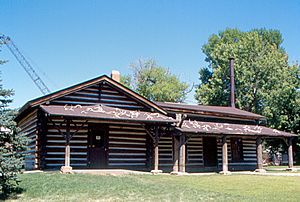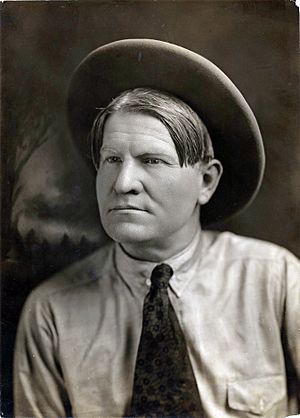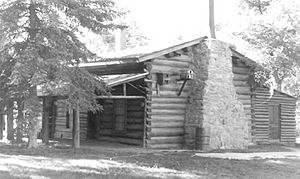C. M. Russell Museum Complex facts for kids
 |
|
| Lua error in Module:Location_map at line 420: attempt to index field 'wikibase' (a nil value). | |
| Established | 1953 |
|---|---|
| Location | 1217-1219 4th Avenue North, Great Falls, Montana, U.S. |
| Type | Art museum |
| Visitors | 37,884 (2014) |
|
Charles M. Russell House and Studio
|
|
| Location | 1217-1219 4th Avenue North, Great Falls, Montana, U.S. |
|---|---|
| Built | House (1900); Log Cabin Studio (1903) |
| Architect | George Calvert (house); Charles M. Russell (log cabin) |
| Architectural style | Arts & Crafts (house); Vernacular (log cabin) |
| NRHP reference No. | 66000430 |
| Significant dates | |
| Added to NRHP | October 15, 1966 |
| Designated NHL | December 21, 1965 |
The C. M. Russell Museum Complex is an art museum in Great Falls, Montana, United States. It is named after the famous "cowboy artist" Charles Marion Russell. The museum mainly shows Russell's artwork. You can also see his illustrated letters and the tools he used. These items help visitors understand his life and how he worked.
The museum also displays art from the 1800s, 1900s, and 2000s. This art shows the American Old West, including its plants, animals, and landscapes. In 2009, the Wall Street Journal called it "one of America's premier Western art museums."
On the museum grounds, you can find Russell's log cabin studio and his two-story wooden home. These buildings are very important. They were named a National Historic Landmark in 1965. They were also added to the National Register of Historic Places in 1966.
Since 1969, the museum has hosted art auctions. These auctions sell Western art from different centuries. The money raised helps the museum. These auctions have been noticed around the world. In 2010, the museum started its own auction called "The Russell."
Contents
Discovering the Museum's Story
How the Museum Began
Emma Josephine Trigg was an art teacher and librarian in Great Falls. She knew Charles M. Russell well. Russell often used a back room at her father's saloon as his art studio. In 1900, Russell built his home near the Trigg family. In 1903, he built his log cabin studio between their houses. Josephine and Russell remained friends for many years. She even helped him with his letters and postcards.
Charles M. Russell was a professional artist for 30 years. He created thousands of artworks. After he passed away, his wife, Nancy Russell, kept some of his pieces. Many of his artworks were sold during his lifetime.
A man named Sid Willis, who owned the Mint Saloon, collected many of Russell's paintings. He traded drinks for art. By the time Russell died, Willis had about 90 artworks. In 1948, Willis decided to sell his collection. A group tried to buy it to keep it in Montana, but they couldn't raise enough money. In 1952, a Texas publisher bought the collection for $200,000. He then created the Amon Carter Museum to display it.
Josephine Trigg had her own collection of Russell's art. It included 153 paintings, watercolors, and illustrated letters. Her will stated that these artworks would go to the city if a museum was built to house them. A fundraising effort collected $75,000. The Trigg-Russell Memorial Gallery opened on September 26, 1953. The building cost $58,175 to build.
Growing and Changing Over Time
In its first two years, the museum welcomed 38,000 visitors. By 1960, the museum decided to show art by other artists too. They wanted to include contemporary artists who painted the Old West.
In 1962, the famous "Mint Collection" of Russell's art was shown at the museum. This helped bring in many more visitors. In 1963, over 23,000 people visited. A local builder, John L. McLaughlin, offered $100,000 for an expansion. The museum needed to raise $350,000 to match this gift. The fundraising went well.
Construction on the new addition began in 1968. The new galleries opened in 1969. To help raise money, a local TV personality, Norma Ashby, suggested an art auction. This auction would sell Old West art and help the museum. The first auction was held in March 1969.
In 1970, another new gallery opened. A rancher named Charles A. Bovey helped pay for it. He was interested in Montana's history and had collected many old items.
In 1972, the museum officially changed its name to the C.M. Russell Museum. The collection continued to grow. In 1975, Richard J. Flood donated over 1,000 Russell letters and other items. These were worth $600,000. In 1979, a life-size bronze statue of Russell by Robert Scriver was placed outside the museum.
By 1980, the museum had bought more land nearby. In 1982, they started a $3 million campaign to double the museum's size. The city of Great Falls also gave the museum control of Russell's home and studio. In 1985, the new addition to the museum opened. By 1989, the museum had seven galleries. They displayed 7,500 items, including art, personal items, and photographs. This included 80 Russell paintings and 120 Russell sculptures.
The museum took full ownership of the Russell home and studio in 1991. In 1994, they spent $250,000 to fix up the log cabin. The museum also bought Russell's large oil painting, "The Exalted Ruler," for $1.1 million.
In 1997, the museum started another fundraising campaign called "Trails to the Future." This aimed to raise $5 million for another expansion. They also fixed the outside of the Russell home.
The "Trails to the Future" campaign finished in 2000, raising $6.5 million. The expansion added 30,000 square feet to the museum. It also increased gallery space by 33,000 square feet. The new space allowed more Russell artworks to be shown. It also included a new gallery for contemporary artists. Other new areas included a children's space and a photography gallery. A new library and research center were also added.
The new expansion opened in 2001. The Great Falls Tribune newspaper said the museum became one of the world's major Western art museums. The main entrance of the museum moved to the north side. Many artworks that were in storage were now put on display.
In 2002, an anonymous person bought Russell's watercolor "Waiting" for $240,000. They then donated it to the museum. In 2003, the museum bought Russell's oil painting "Four Generations."
In 2004, the museum changed how it displayed Russell's art. They started showing his works in order of when they were created. This helped visitors see how he grew as an artist. The museum also received grants to improve its exhibits. In 2005, the museum moved the 200-piece Browning Firearms Collection to the front. They also opened a popular cafe.
In 2007, the Mitch family donated over 50 bronze sculptures by Robert Scriver. In 2008, the museum received a $375,000 grant for a new exhibit called "The Bison: American Icon, Heart of Plains Indian Culture." This exhibit cost $1.5 million in total. In 2011, the museum received three more Russell artworks. These included "The Lone Wolf" (1900), "The Last Laugh" (1916), and "When the Longest Blade Was Right" (1922).
As of 2011, the museum had 76,000 square feet of space. It owned about 2,000 pieces of art and other items related to Russell.
Museum Visitors and Funding
The museum had about 19,000 visitors each year in 1953 and 1954. From 1955 to 1958, it had about 10,500 visitors yearly. By 1963, visitorship rose to over 23,000 people a year.
In 2003, the museum reported that 76 percent of its visitors were from outside Montana.
| Year | Visitorship |
|---|---|
| 1998 | 60,397 |
| 1999 | 57,582 |
| 2000 | 48,540 |
| 2001 | 54,157 |
| 2002 | 51,534 |
| 2003 | 51,758 |
| 2004 | 45,133 |
| 2005 | 50,000 |
| 2006 | 45,973 |
| 2007 | 39,503 |
| 2008 | 39,282 |
| 2009 | ? |
| 2010 | 30,689 |
| 2011 | 34,314 |
| 2012 | 33,016 |
| 2013 | 32,424 |
| 2014 | 37,884 |
In 2006, the museum's director explained how the museum gets its money. It comes from the yearly art auction, memberships, donations, museum admissions, and sales from the museum shop. In 2011, "The Russell" auction made $1.35 million in sales.
The Russell: An Auction for the Museum
In 1969, a local business group and Norma Ashby started the first C.M. Russell Art Auction. Part of the money from selling Western art went to the C.M. Russell Museum. This auction grew into a week-long event called Western Art Week. It is now the largest Western art auction and exhibition in the United States. Between 1969 and 2003, the auction raised $16 million. Of that, $3,771,088 went to the museum.
In 2009, the museum started its own auction, "The Russell: The Sale to Benefit the C.M. Russell Museum." The first "Russell" auction in 2010 brought in $605,473.
How the Museum is Managed
The Trigg-C.M. Russell Foundation runs the museum, home, and log cabin studio. It is managed by officers and a board of directors. There are currently five officers and 43 members on the board.
The museum has had several changes in its leadership over the years. In 1999, the executive director resigned. Several people served as interim directors. In 2000, Michael Warner became the new executive director, but he resigned in 2001.
In 2002, Inez Wolins was hired as the new executive director. She was later fired in 2004. After that, Anne Morand, the curator of art, became the executive director. She resigned in 2008. Darrell G. Beauchamp then became the new executive director. He resigned in 2011.
Due to economic challenges, the museum decided to wait to hire a new executive director. Michael D. Duchemin was hired as the new executive director on May 1, 2013. He had experience from other museums. The museum's chief curator, Sarah L. Burt, passed away in 2015.
Russell's Home and Studio
In 1896, Charlie Russell and his wife, Nancy, lived in a small shack. In 1897, they moved to a rented home in Great Falls. In 1900, Russell's father gave them money. They started building a new home on 13th Street and 4th Avenue North. A friend, George Calvert, likely designed and built the house.
The house was a two-story wooden building with a gable roof. It had simple outside decorations. The front door led to a small hall and a parlor. The first floor also had a dining room, bathroom, kitchen, and a small maid's room. Some furniture, like seats and a bookcase, were built into the house. A steep staircase led to three small bedrooms and a bathroom upstairs. The inside was paneled with dark wood. A small porch wrapped around the southeast corner. The house was built in the Arts and Crafts style. The Russells moved into the home in the summer of 1900.
That same year, Charlie Russell wanted to build a log cabin studio. He used Western red cedar telephone poles to build the one-room cabin. He also built a rock fireplace and chimney. The cabin was 24 feet long by 30 feet wide. It had a porch across the south side, decorated with elk antlers. A skylight was built into the roof. Russell later raised the roof to fit larger canvases. The inside was filled with handmade furniture, animal skins, and cowboy gear.
The Trigg family home was next to the log cabin studio. A horse stable was between the two buildings. The Trigg house and stable were torn down in 1953 to build the C.M. Russell Museum. The Russells also built a stone wall in front of their properties. It had a concrete emblem with Russell's trademark, a cattle skull and his initials.
In 1973, the museum moved Russell's house 50 feet east and 50 feet north from its original spot. The house's back porch was removed. The log cabin studio also saw some changes. In 1928, Nancy Russell agreed to let the city manage the log cabin studio. Between 1928 and 1930, the city added a large L-shaped section to the studio. This part acted as a gallery for Russell's art. In 1930, Nancy opened the studio to the public as a memorial to Charlie Russell. The inside of the log cabin is still much like it was when Russell used it.
Nancy Russell's will gave both buildings to the city of Great Falls. The city parks commission managed them until 1991. Before 1976, the city allowed the Montana Federation of Garden Clubs to furnish the house with furniture from that time. They also provided guides to help visitors learn about the home.
In 1966, the city of Great Falls thought about tearing down the Russell house. They wanted to build a parking lot for the museum. Many people, including the Montana Historical Society, opposed this idea. The city argued that the house was a fire hazard and that Russell didn't like it. They also said it took away from the studio and museum. The National Park Service wanted the house to stay. Eventually, the Garden Clubs helped make a deal. The house was moved to its current location instead of being torn down.
After the house moved in 1973, the Garden Clubs began to fix it up. The city repainted the outside and replaced broken windows. The Garden Clubs repainted the inside and refurnished the house. By 1976, they were working on the second floor.
The National Park Service noted that the site's original look had changed a lot. The museum now crowded the studio. Moving the house changed its relationship with the studio, which was important to Charlie Russell. The city and museum also removed the original paths that showed where the house once stood.
The Russell home is open from May to September. It has furniture from that time period, some of which belonged to the Russells. The log cabin studio is also furnished with items from the early 1900s. Some of these items belonged to Russell.
Images for kids








